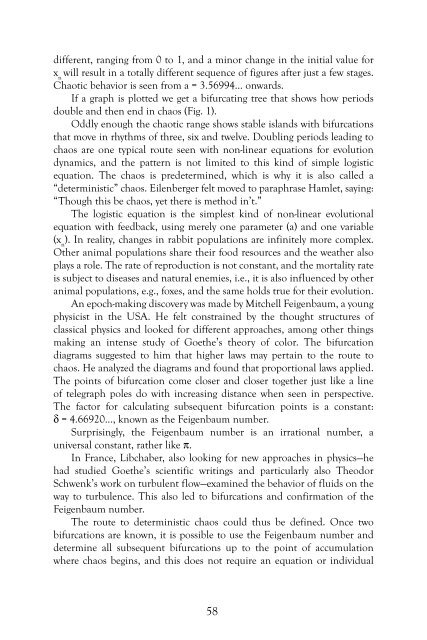When Healing Becomes Educating, Vol. 2 - Waldorf Research Institute
When Healing Becomes Educating, Vol. 2 - Waldorf Research Institute
When Healing Becomes Educating, Vol. 2 - Waldorf Research Institute
Create successful ePaper yourself
Turn your PDF publications into a flip-book with our unique Google optimized e-Paper software.
different, ranging from 0 to 1, and a minor change in the initial value for<br />
x n<br />
will result in a totally different sequence of figures after just a few stages.<br />
Chaotic behavior is seen from a = 3.56994... onwards.<br />
If a graph is plotted we get a bifurcating tree that shows how periods<br />
double and then end in chaos (Fig. 1).<br />
Oddly enough the chaotic range shows stable islands with bifurcations<br />
that move in rhythms of three, six and twelve. Doubling periods leading to<br />
chaos are one typical route seen with non-linear equations for evolution<br />
dynamics, and the pattern is not limited to this kind of simple logistic<br />
equation. The chaos is predetermined, which is why it is also called a<br />
“deterministic” chaos. Eilenberger felt moved to paraphrase Hamlet, saying:<br />
“Though this be chaos, yet there is method in’t.”<br />
The logistic equation is the simplest kind of non-linear evolutional<br />
equation with feedback, using merely one parameter (a) and one variable<br />
(x n<br />
). In reality, changes in rabbit populations are infinitely more complex.<br />
Other animal populations share their food resources and the weather also<br />
plays a role. The rate of reproduction is not constant, and the mortality rate<br />
is subject to diseases and natural enemies, i.e., it is also influenced by other<br />
animal populations, e.g., foxes, and the same holds true for their evolution.<br />
An epoch-making discovery was made by Mitchell Feigenbaum, a young<br />
physicist in the USA. He felt constrained by the thought structures of<br />
classical physics and looked for different approaches, among other things<br />
making an intense study of Goethe’s theory of color. The bifurcation<br />
diagrams suggested to him that higher laws may pertain to the route to<br />
chaos. He analyzed the diagrams and found that proportional laws applied.<br />
The points of bifurcation come closer and closer together just like a line<br />
of telegraph poles do with increasing distance when seen in perspective.<br />
The factor for calculating subsequent bifurcation points is a constant:<br />
d = 4.66920…, known as the Feigenbaum number.<br />
Surprisingly, the Feigenbaum number is an irrational number, a<br />
universal constant, rather like p.<br />
In France, Libchaber, also looking for new approaches in physics—he<br />
had studied Goethe’s scientific writings and particularly also Theodor<br />
Schwenk’s work on turbulent flow—examined the behavior of fluids on the<br />
way to turbulence. This also led to bifurcations and confirmation of the<br />
Feigenbaum number.<br />
The route to deterministic chaos could thus be defined. Once two<br />
bifurcations are known, it is possible to use the Feigenbaum number and<br />
determine all subsequent bifurcations up to the point of accumulation<br />
where chaos begins, and this does not require an equation or individual<br />
58
















